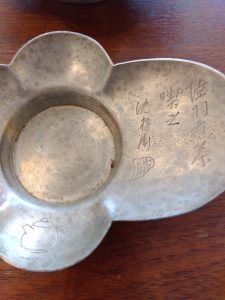茶托の世界をのぞいてみる(愛知県名古屋市千種区姫池通 骨董買取 古美術風光舎)
2024.10.11
皆さまこんにちは。スタッフTでございます。
すっかり朝晩は涼しくなりましたが、今日はすっきりとした秋らしいお天気となりました。ですが、気温はぐんぐん上がり、少し歩くと上着がいらないくらい汗ばんできました。先日のブログの秋のかさね色目が頭に浮かび、秋っぽい感じの服装をチョイスしてみましたが、まだ早かったようです。
とはいえ、朝晩は冷えますので、そろそろ温かい飲み物で一息入れたくなります。珈琲派でしたが、最近はあたたかい日本茶にしてみようと思うことが多くなりました。手軽さ故、ティーバッグで淹れたお茶をがぶがぶと飲んでしまう私ですが、たまには趣のある茶器で一口ずつ味わいながら、美味しいお茶をいただく…そんな丁寧な暮らしに憧れます。
店内にも手に取ってみたいと気になる、茶道具のひとつである「茶托」があります。
大切な方やお客様をおもてなしするアイテムとして備えておきたい、身近なような、身近でないような・・・「茶托」。
そもそもお茶を飲む習慣は平安時代には既にあったのですが、「茶托」は江戸時代中期に清から杯と杯台が輸入されるようになり、杯と杯台の代わりに、茶碗と茶托が使われるようになったのが始まりとされています。
輸入された杯台が錫製だったため、錫製の茶托が最上とされるようになり、また、錫製の茶托は煎茶、玉露などの高級茶を入れる小さめの茶碗を使用する際に使われる茶托ですので、自ずと高級感が増してきます。

こちらは沈存周(1629~1709)の錫製の茶托です。沈存周は中国の清の時代の錫器の優れた名工であり、詩人でもありました。主に茶道具に詩と共に山水画などの絵を彫り、錫器の価値を高めたと言われています。沈存周は別号の「仙子」という文字を刻んだ茶器も制作しており、同じく価値のあるものとされています。
錫器は使い込むほどに古色が加わり光沢が増し、価値も上がっていきます。こちらの5客セットの茶托も漢詩とその情景を表した絵が錫の変化と共に味わい深い姿になっています。

目を凝らしてみると、茶托のひとつには「陸羽 煮茶」の文字が見られます。
陸羽とは唐の時代にお茶の専門書「茶経」を書いた人物です。お茶の起源や製造方法、茶器、お茶の淹れ方、飲み方、産地などが書かれており中国茶のバイブル的な存在です。この書物を書いた時、陸羽はまだ20代だったそうです。単なる飲み物にすぎなかったお茶は、陸羽以降、精神性・神聖さを帯び、のちの日本の茶道につながっていったようです。
こちらの茶托にも茶道具がたくさん描かれています。また、他に描かれているのは中国の当時の様子でしょうか。その描かれた画が一つ一つ違っており、それを眺めるのもまた楽しいです。
お茶は「百薬の長」とも言われます。若い世代を中心に日本人の”お茶離れ”が進んでいると数年に一度くらい(?)聞こえてきますが、この茶托を眺めながら、もう少しお茶を飲む機会を増やそうかなと思いました。
ではでは、また。
Hello everyone. This is Staff T.
It has become cooler in the mornings and evenings, but today’s weather was clear and autumn-like. However, the temperature has been rising rapidly, and I am sweating so much that I don’t even need a jacket when I walk around a little. The autumnal hues of my recent blog entry came to mind, and I tried to dress in autumn-like clothes, but it was still too early to tell.
However, the mornings and evenings are chilly, so it’s time to take a break with a warm drink. I used to be a coffee drinker, but recently I have been thinking of trying warm Japanese tea. I tend to drink tea made in a tea bag because it is easy and convenient, but sometimes I long for a more careful lifestyle where I can savor a cup of tea in an elegant tea container and savor each sip.
In the store, there is a teacup “saucer,” one of the tea utensils that I am interested in picking up.
Chasou (tea saucer)” is a familiar or unfamiliar item that we would like to have as an item for entertaining our loved ones and guests.
The custom of drinking tea had already existed in the Heian period (794-1185), but it is said that “chasake” originated in the mid-Edo period when cups and cup stands were imported from the Qing dynasty (1644-1911), and tea bowls and saucers came to be used instead of cups and cup stands.
Since the imported cup stand was made of tin, tin saucers came to be regarded as the best, and since tin saucers are used for small tea bowls for high-grade teas such as sencha and gyokuro, they naturally have a more luxurious feel.
This is a tin saucer made by Shen Zun Zhou (1629-1709). Shen Zun-chou was an excellent tinware master craftsman and poet in the Qing Dynasty of China. He is said to have engraved landscapes and other pictures along with poems mainly on tea utensils, thereby enhancing the value of tinware. Shen Zun Zhou also produced tea utensils engraved with the character “Xian Zi,” which is another name for the tea ceremony, and is also considered to be of great value.
The more tinware is used, the more it becomes old and shiny, and the more valuable it becomes. This set of five saucers also features Chinese poetry and pictures depicting scenes from the poem, and the tin has changed over time, giving the saucers a deeply tasted appearance.
If you look closely, you can see the words “Lu Yu boiled tea” on one of the saucers.
Lu Yu was the author of the “Tea Sutra,” a technical book on tea during the Tang Dynasty. The book is the bible of Chinese tea, as it describes the origins of tea, its production methods, tea utensils, how to brew tea, how to drink tea, where it is produced, and more. Rikuyu was still in his 20s when he wrote this book. Tea, which had been merely a beverage, became more spiritual and sacred after Rikuu’s death, leading to the Japanese tea ceremony later on.
This saucer also depicts many tea utensils. The other paintings are probably scenes from that time in China. The paintings are different one by one, and it is fun to look at them.
Tea is said to be “the best of all medicines. Every few years (?) we hear that Japanese people, especially the younger generation, are becoming less and less interested in tea. Looking at this saucer, I thought I would like to increase my opportunities to drink tea.
See you soon.
*******************
ご実家の整理やお片付けなどをされている方のご相談などが多くございます。
お片付けなどくれぐれもご無理のないようになさってくださいませ。
風光舎では古美術品や骨董品の他にも絵画や宝石、趣味のお品など様々なジャンルのものを買受しております。
お片付けをされていて、こういうものでもいいのかしらと迷われているものでも、どうぞお気軽にご相談下さいませ。
また風光舎は、出張買取も強化しております。ご近所はもちろん、愛知県内、岐阜県、三重県その他の県へも出張いたします。
まずは、お電話お待ちしております。
愛知県名古屋市千種区姫池通
骨董 買取【古美術 風光舎 名古屋店】
TEL052(734)8444
10:00-17:00 OPEN
#出張買取#骨董#古美術#骨董品#絵画#版画#茶道具#刀剣#彫刻

